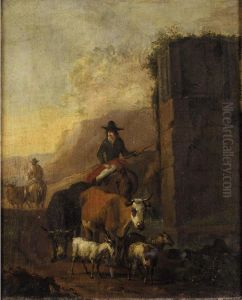Sebastian Heemskerck Paintings
Maerten van Heemskerck, born in 1490 in Heemskerk, a small town near Haarlem in the Netherlands, was a prominent figure in the Northern Renaissance art movement. Although often referred to as Maerten van Heemskerck, confusion sometimes arises with variations of his name, leading to occasional misidentification as Sebastian Heemskerck. Heemskerck's career spanned a period of significant change in European art, characterized by a heightened interest in humanism, the natural world, and the rediscovery of classical antiquity.
Heemskerck's early life was marked by apprenticeships with several artists, including Jan van Scorel, who was a significant influence on his style and career. Van Scorel's influence is evident in Heemskerck's initial works, which combined the detailed realism of the Northern Renaissance with the emerging Italianate styles. This blend of influences became a hallmark of Heemskerck's work, distinguishing his contributions to art history.
In the 1530s, Heemskerck embarked on a pilgrimage to the Holy Land, but the journey profoundly influenced his artistic direction, as he stopped in Rome. The exposure to classical art and the Renaissance masters significantly impacted his style, leading to a shift towards more monumental compositions and a deeper engagement with antiquity's themes and motifs.
Upon returning to the Netherlands, Heemskerck became one of the leading artists in Haarlem, contributing to the city's status as a cultural and artistic hub. His works from this period include altarpieces, portraits, and mythological scenes, showcasing his versatility and mastery of different genres. Heemskerck's interest in classical antiquity was not limited to thematic exploration; he also engaged with architectural elements, incorporating them into his works to create complex, layered compositions.
Heemskerck's legacy is marked by his contributions to the development of Northern Renaissance art, bridging the gap between the detailed realism of his Dutch heritage and the idealized forms of the Italian Renaissance. His works are celebrated for their intricate details, vibrant colors, and dynamic compositions, earning him a place among the era's most influential artists. Heemskerck passed away in 1567, leaving behind a body of work that continues to be studied and admired for its artistic significance and historical importance.
